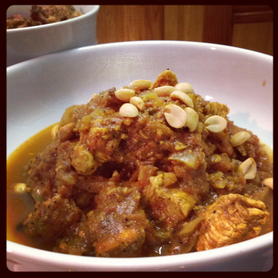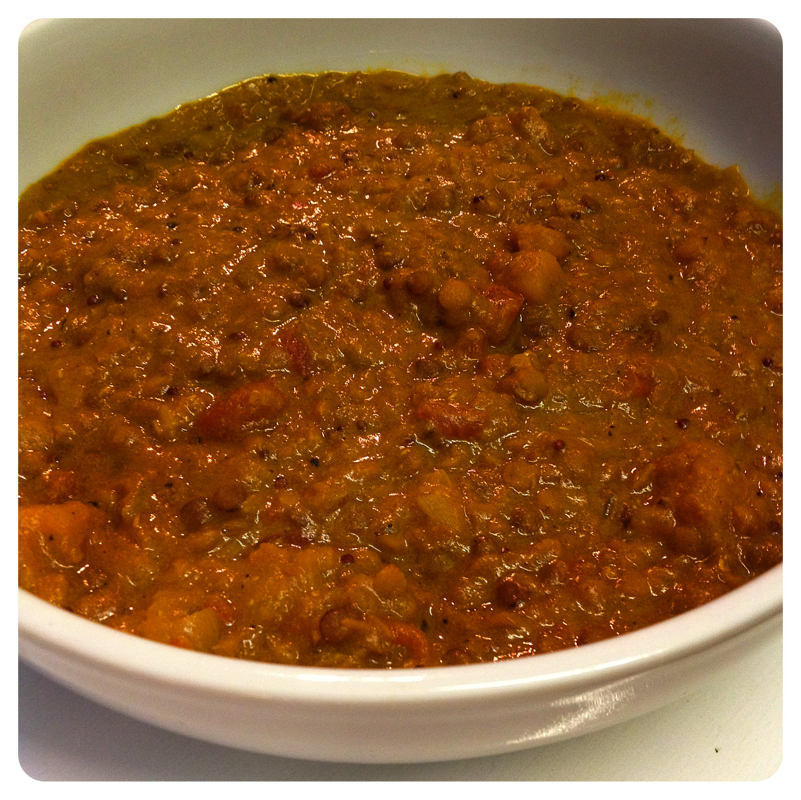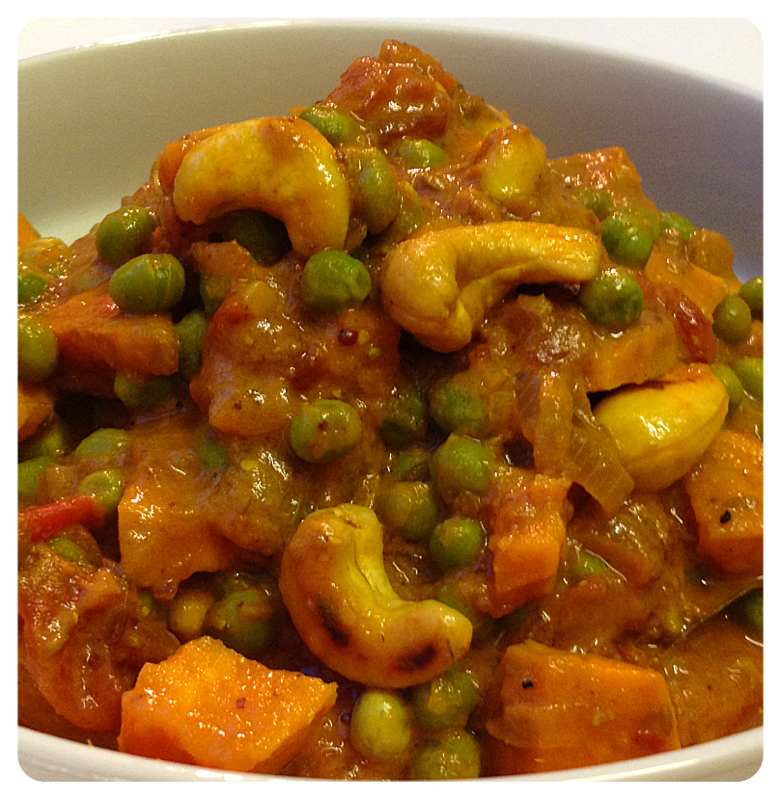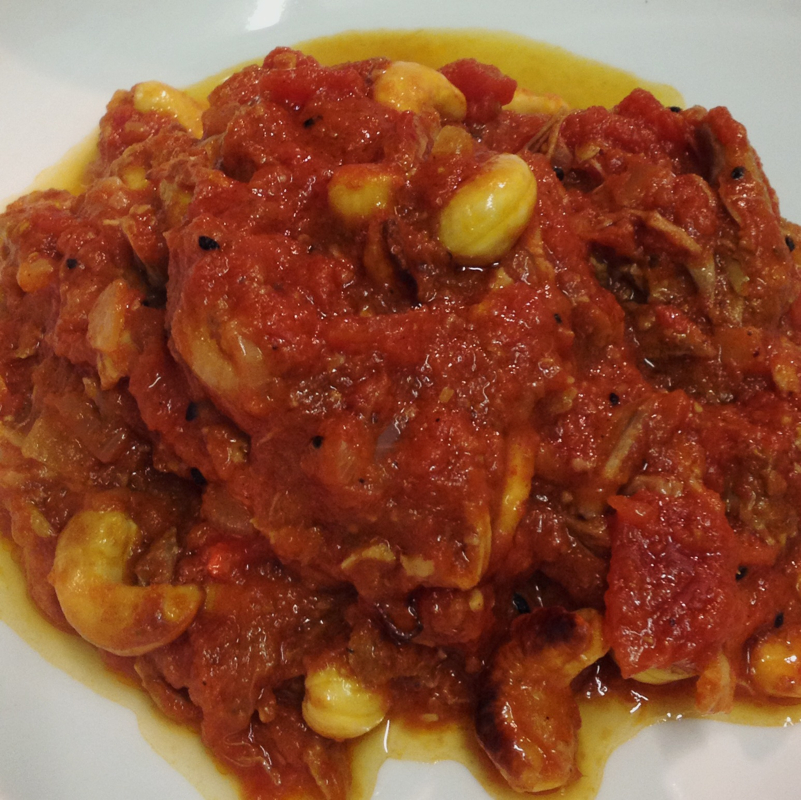I've only recently got into lentils. My suspicion was that they would be tasteless and dull. I could not be more wrong. My first foray was with puy lentils, both with sausages and duck. Delicious. Now, with my love of Indian food, surely the obvious next step was daal? On my various travels around India, I honestly don't remember eating daal, which seems impossible. I've made several version, with different types of pulses, but this is the first and still my favourite. The addition of the butternut squash gives a lovely sweetness and much of it tends to melt into the sauce. The lentils should be deliciously creamy and the coconut milk gives a lovely gloss. If you want to make it more non-veg, you could add some chicken about 20mins before it's ready, but it really doesn't need it - in fact I found it distracts from the beautiful richness of the daal. Ingredients:
75g green lentils, rinsed
75g red lentils, rinsed
1 large onion, finely chopped
1tsp garlic purée
1 tsp ginger purée
2 tsp ground cumin
2 tsp ground coriander
2 tsp black mustard seeds
1 tsp ground turmeric
½ tsp cayenne
½ tsp asafoetida
½ tsp cinnamon
375 ml chicken (or vegetable) stock
200g canned chopped tomatoes
200g butternut squash, cubed
200 ml coconut milk
1 tbsp muscavado sugar
½ tsp garam masala
How to make it:
1. Rinse the lentils at least 3 times with cold water.
2. Heat some oil in a large frying pan and cook the onion, stirring, for at least 15mins until they start to brown.
3. Add the spices [except the garam masala], garlic and ginger and stir through until the spices release their fragrance. Don't let them burn - add a few spalshes of water if need be.
4. Add the lentils and stir for a few minutes until they're coated in the spices.
5. Add the stock and bring to the boil.
6. Stir in the tomato and butternut squash, then cover and cook over a very low heat on the hob for two hours, stirring every now and again.
7. Mash a few of the lentils against the side of the pan with a spoon to thicken the sauce.
8. Stir in the sugar and garam masala. Add the coconut milk a few spoonfuls at a time, allowing it to absorb into the lentils before you add more. This will take about another 10-15mins. 9. Taste and check the flavour, adding salt, sugar or some extra coconut milk as needed.
This is my all time favourite curry to make. This was one of the first I made but I constantly come back to it because it never goes wrong and never disappoints. The tang of tamarind should be strong, but balanced by the sweetness of the potato and peas.
If you think you haven't tried tamarind before, you probably have, as it's an ingredient in both Worcestershire Sauce and HP Sauce. The pod-like fruit of a tree, you can buy it in supermarkets either as a solid block or a runnier paste. You can use either, though it will take more for the more solid version to break down in the sauce.
Here the sweet potato is soft but sweet from roasting. I've also cooked it in exactly the same way but without the oil, which gives the same flavour but a much firmer texture. You need to keep more of an eye on it though, in case it catches.
Ingredients:
Spice mix
2 tsp corriander seeds
1½ tsp cumin seeds
½ tsp mustard seeds
½ tsp peppercorns
½ tsp chilli powder
½ tsp ground tumeric
500g sweet potato, peeled and cubed
1 sweet white onion sliced
1 tsp ginger puree
½ tsp garlic puree
½ tsp dried chilli flakes
8-10 curry leaves
400g chopped tomato
2 tsp brown sugar
1 tbsp tamarind paste
400ml reduced fat coconut milk
150g frozen peas
A handful of unsalted cashew nuts
How to make it:
1. Pre-heat the oven to 160C/gas 3.
2. Put the cubed sweet potato into a bowl and add 1 tbsp of oil. Mix thoroughly so that all the potato is lightly coated with the oil. Spread the potato out on a baking sheet covered with greaseproof paper and bake for around 20mins, depending on how big you've cut the cubes.
3. For the spice mix, grind the whole spices with a pestle and mortar to a fine powder, then add the chilli powder and tumeric.
4. Fry the onion on a medium heat for about 20mins, stiring frequently until it starts to brown. If you want to save time you can just fry it until soft but you'll get a deeper flavour with more time.
5. Add the spice mix, curry leaves, chilli flakes, ginger and garlic with the onion and cook for a couple of minutes, stiring to make sure the spices don't burn. If you think they're getting too hot, add a few splashes of water.
6. Add the tomato and turn the heat up a bit, then cook for a couple of minutes. Add the coconut milk, sugar and tamarind paste. Bring up just to the boil, then reduce the heat and simmer gently for 15mins.
7. Taste to test the balance of tangy and sweet, adjusting the sugar and tamarind as needed. Season with a few pinches of salt.
8. Add the peas straight from frozen - you want them to defrost and warm through but not cook so long that they lose their flavour.
9. Toast the cashew nuts in a dry pan, moving them constantly to make sure that they brown but don't burn. Add them to the other pan.
10. Add the roasted sweet potato to the pan and stir through, making sure all the elements are hot before serving.
One of my favourite things to make for Friday Night Curry is pork vindaloo.
I spent a relaxing holiday in Goa a few years ago - it was very different to lots of the other parts of India I'd visited, a much more easy going than the big cities. The food was also delicious. There's a big cashew industry, so you find a lot of them in dishes. I also got to visit a spice farm and it was really interesting to see things like pepper and nutmeg growing - and made me realise just how little I actually know about where spices come from.
The Portuguese influence is very obvious in Goa and it's said that vindaloo has its roots in a Portuguese dish: Carne de Vinha d' Alhos, pork cooked with wine and garlic. Vindaloo subsitutes wine vinegar for wine, which gives a lovely tang against the sweet pork.
Although pork is more common, it's also traditional to make it with duck, with gives a similar sweetness. If I'm making this with pork shoulder, I would normally marinate the pork in the spice paste for a couple of hours first but there's really no need to do that with duck.
Ingredients:
2 duck legs
1 tsp cumin seeds
5 black peppercorns
Seeds from 2 cardamom pods
2 cloves
1 tsp corriander seeds
Half tsp ground cinnamon
1 tsp ginger puree
1 tsp garlic paste
Half tsp chilli flakes
3 tbsp white wine vinegar
1 finely chopped onion
1 tin chopped tomato
1 tsp muscovado sugar
1 tsp black mustard seeds
A handful of unsalted cashews
How to make it:
1. Pre-heat the oven to 180c/gas 4
2. Season the duck legs with salt and pepper, place skin up on a baking tray and roast for 1 hour 30 mins.
3. Grind the cumin, peppercorns, cardamom, cloves and corriander with a pestle and mortar until fine.
4. Put half the onion, ground spices, cinnamon, ginger, garlic, chilli and vinegar in a blender and blend to produce a smooth paste.
5. Fry the other half of the onion until golden brown.
6. Add the spice paste and fry until the oil starts to come out but don't let it burn.
7. Add the tomato and sugar, cover and simmer on mimimum heat for 40mins.
8. Remove the duck from the oven and allow to rest for at least 30mins.
9. Taste the sauce and adjust the sugar/vinegar/chilli balance as needed.
10. Remove the duck meat from the bones - try and keep it quite chunky if you can.
11. Stir the duck into the sauce and let it warm through.
12. Meanwhile, in a separate pan add a little oil and fry the mustard seeds until they pop.
13. Add the cashews and fry until they turn golden brown - keep them moving or they will burn.
14. Add the cashew/mustard seed/oil mix straight into the sauce and stir.
15. Serve immediately with rice or bread.
 It's National Curry week which is a good enough reason to have a curry. But at our house every Friday is curry night. My husband and I take it in turns to whip up a spicy feast and it always says 'hurrah the weekend has started!'
I wasn't really a fan of Indian food until I spent quite a bit of time there. I haven't by any means seen all of India but have been to Delhi, Mumbai, Agra, Shimla, Amritsar, Goa and Dharamshala amongst others, so I have tried different styles of food. I also spent 5 weeks teaching English in a slum school in Jaipur, staying in a £10 a night hotel with an amazing vegetarian restaurant.
Making a curry every week means we spend a lot of time looking for different recipes and this is one of our favourites. Xacutti is a curry from Goa and makes the most of toasted spices and the tang of tamarind.
Last week I spent the weekend in Portugal with girlfriends and, tiring of endless menus of steak and fish, we went for an excellent Indian (check out Masala if you're ever in Cascais).
I was surprised to see Xacutti on the menu, as it's not a dish that you'd usually find on a menu in the UK, but it makes sense as Goa was formerly a Portuguese colony. The dish incorporates coconut flesh, as so many Goan dishes do, and toasting the spices before grinding gives it a really deep earthy flavour.
Ingredients:
Marinade
Squeeze of garlic purée
Squeeze of ginger purée
1 tsp ground coriander
1 tbsp tamarind paste
1/2 tsp ground tumeric
1/2 tsp chilli powder
450g diced chicken breast
Masala mix
1 tbsp sesame seeds
1/2 tbsp poppy seeds
1/4 tsp chilli flakes
1tsp cloves
1 tsp black peppercorns
1 tbsp fennel seeds
1 tbsp coriander seeds
2 tbsp grated coconut
1tbsp cumin seeds
1 tbsp peanuts
Sauce
1 onion very finely chopped
1 tbsp grated coconut
400g tin chopped tomato
1/2 tsp cinnamon
Method:
1. Mix all the marinade ingredients together and smother the diced chicken thoroughly with the mixture. Leave while you prepare the masala.
2. Heat a frying pan (no oil) and add all the masala ingredients. If you don't want it so warm, leave out the chilli flakes. Immediately remove the pan from the heat and swirl the spices around in the hot pan until they are toasted and fragrant. Make sure they don't burn, especially the smaller sesame and poppy seeds.
3. Remove the spices and wipe the pan clean with kitchen towel.
4. Grind the spices using either a coffee grinder or a pestle and mortar. If you're doing it manually, make sure you spend enough time so that the spices are all finely ground - biting into a whole clove or peppercorn will be a nasty surprise later.
5. Fry the onion in a tbsp of oil until it softens, then add the ground spice mix and fry for a few minutes.
6. Add the tomato a little at a time to stop the temperature dropping and then add the cinnamon.
7. Add the marinated chicken and the extra coconut.
8. Cook for 20 minutes or until the chicken is cooked. If it starts to dry out too much, add splashes of warm water.
9. Check the seasoning and add some salt to bring out the flavours if needed.
9. Served sprinkled with some extra peanuts and some rice or chappatti.
|






 RSS Feed
RSS Feed